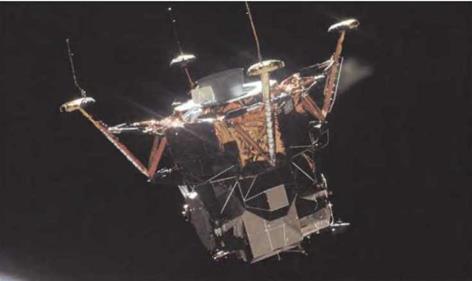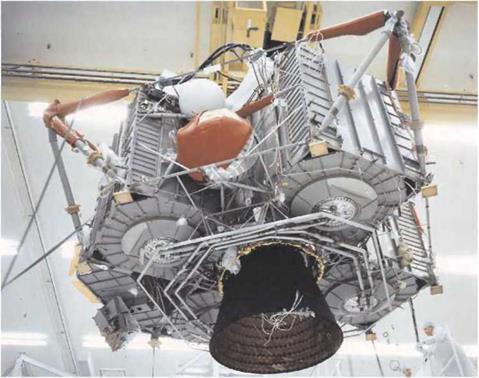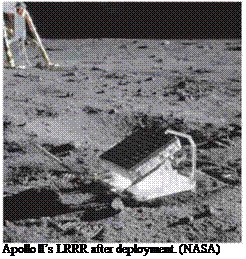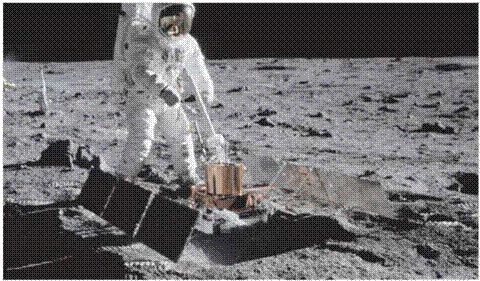The various rescue plans for the CSM meant nothing if the LM could not get off the Moon and reach some kind of orbit. Should the ascent engine have underperformed for some reason and come up significantly short on velocity, the surface crew would be doomed within an hour of lift-off. If il failed to ignite, they w’ere doomed to expire on the surface. This was Michael Collins’s private fear as Neil Armstrong and Buzz Aldrin prepared to make their ascent in the top half of Eagle. “When the instant of lift-off does arrive, I am like a nervous bride. I have been flying for 17 years, by myself and with others; I have skimmed the Greenland ice cap in December and the Mexican border in August; I have circled the Earth 44 times on board Gemini 10. But I have never sweated out any flight like 1 am sweating out the LM now-. My secret terror for the last six months has been leaving them on the Moon and returning to Earth alone; now’ I am within minutes of finding out the truth of the matter. If they fail to rise from the surface, or crash back into it, I am not going to commit suicide; I am coming home, forthwith, but I will be a marked man for life and I know it.”
When compared lo the fuss and bother of a launch from Earth, with its enormous launch gantries, heavy conerete pads, ground support equipment and launch control facilities, it is almost amusing to consider the relative ease with which two Apollo crewmen harnessed themselves into position, configured their spacecraft for launch and pressed a button to get themselves off the surface of another planet. The difference, of course, is that Earth is at the bottom of a very deep gravity well and every last item required for an Apollo voyage had Lo be lifted through a thick atmosphere and hurled towards the Moon. Such a feat required a vehicle of immense power and complexity the Saturn V and a cast of hundreds to send il on its way. The LM ascent stage, on the other hand, was a far simpler machine, made as light as could be and it would launch from an airless world whose gravity was barely one-sixth that of Earth. And given that its task was merely to rendezvous, it would require to provide only several hours of life support.
By the time the advanced Apollo missions got into their stride, NASA had enough confidence to partially power the LM down during the lunar stay, conserving battery power and permitting three days of exploration. In particular, the primary guidance and navigation system (PCNS) was turned off. Turning it back on involved a complete realignment of its guidance platform. As with platform alignments in space, Lite crew used the alignment optical telescope (AOT) mounted into the Lop of the LM to sight on a star. A major difference in the procedure came from the use of the direction of gravity as their second reference.
Earlier, the crew had temporarily depressurised the LM cabin to throw out any items not needed for the journey to orbit, especially the back packs that had kept them alive on Lite surface. They would keep their suits on until they returned to the CSM but would be connected directly to the LM’s supply of oxygen and coolant. Other equipment and samples had to be carefully stowed in predetermined positions around the cabin to ensure that the centre of mass of the ascent stage remained as near to ideal as possible the further it was from ideal, the more the RCS thrusters had to work during the ascent to maintain the stage’s attitude.
If the pressure of time allowed, the surface crew would try to test their rendezvous radar on the CSM as the mothership passed over the landing site one orbit prior to lift-off. The rendezvous radar worked with a transponder on the CSM to provide range, range-rate and direction to its quarry. Its dish was mounted above the LM’s front face and could move up and down or side Lo side as it tracked the CSM from a distance of up to 750 kilometres. At the same time, the CMP carried out a tracking program in his computer to help aim the 28-power sextant at the landing site. By taking marks on the LM centred in his viewfinder, he helped mission control to improve their reckoning of the LM’s state vector information that was loaded into the LM computer shortly before lift-off.
Mission control then read up a lift-off PAD to both the LM crew and the CMP that gave details of their rendezvous. On later missions, two PADs were sent covering two types of rendezvous – one as a fallback in case the other had to be aborted. With less than an hour to lift-off. the commander gave his RCS thrusters a cheek by firing them while still sitting on the surface. When Pete Conrad did this, he managed to blow over an umbrella-like dish antenna that he and Л1 Bean had deployed on the surface and the resultant loss of communications meant they had to switch over to the high-gain dish on the roof. Power was then switched away from batteries in the descent stage to a pair of batteries in the ascent stage. Flight control displays were set up for flight and the abort guidance system (AGS) was initialised to back up the PGNS for rendezvous guidance.
Proceeding on through the launch checklist, the surface crew donned their helmets and gloves. They were about to ignite the ascent stage’s engine while it sat on top of the discarded descent stage, which raised the possibility of the pressure wave from combustion compromising the LM hull. It was therefore wise to be fully suited for the ascent. Then with all checks completed and only a few’ minutes remaining to lift-off, the crew could make their final preparation to leave the surface.
‘ Stand by. You ready to watch the APS pressurise?’- Apollo 15’s David Scott was checking to make sure that mission control was going to watch the vital signs from the ascent stage’s propulsion system, the APS. Its tanks had remained unpressurised until this point.
“Okay, let’s let her go,” replied Ed Mitchell. It had become customary for the LMP from the previous mission to serve as Capcom for ascent because his awareness of what the LM crew were trying to do made him particularly suited to this role.
To pressurise the tanks, explosively actuated valves from two very-high-pressure helium tanks were operated to release the gas into the propellant tanks and bring them up to their working pressure. Mission control checked each tank in turn, fuel and oxidiser, to ensure that if there were any signs of a leak, lift-off could be carried out as soon as possible in order to minimise propellant loss. “Okay, here comes tank 1.” announced Scott. “And w’e‘11 stand by for your call for tank 2.”
“Roger.” said Mitchell. After a brief pause for flight controllers to monitor tank I’s pressure, Mitchell gave the go-ahead for the second Lank. “Okay. Go with tank 2. looks good.”
“Okay. Tank 2 coming now.”
After another pause, Mitchell confirmed that all wtis well. “Looks good down here.-’
“Okay, thank you. Looks good up here,” replied Scott.
“And, Dave, you’re Go for the direct rendezvous. Both guidance systems look good; PGNS is our recommendation.” Mitchell w’as letting Scott know’ that, of their two practised methods for rendezvous, the flight controllers recommended that they use the planned-for quick technique called direct rendezvous, and that, of their two guidance systems, they should rely on the primary.
“Roger. Go for direct on the PGNS.”
“Okay, loud and clear, Dave, and you’re Go for lift-off.” Then Mitchell reminded the crew’ that it was time for another transition in their roles: “And I assume you’ve taken your explorer hats off, and put on your pilot hats.-’
“Yes sir, we sure have. We’re ready to do some flying.” replied Scott.
“Standing by for one-minute,” prompted Jim Irwin whose primary task was to
look after the AGS and see that its knowledge of the ascent matched that of the PGNS. “Guidance steering is in." was his next call as he commanded the AGS to take its guidance information and generate steering commands for the RCS to use in case of an emergency. With a normal ascent, the guidance mode control switch would route steering commands only from the PGNS, blocking those from the AGS. "
Prcloadcd with the data from the ascent PAD. the PGNS was nearly ready to ignite the engine. “Okay, Master Arm is On; I have two lights," called Scott, as he armed the pyrotechnic system that would sever the two halves of the LM. and saw an indication that the circuits were good.
“Average g is on…” The DSKY display had blanked to show that the PGNS was now calculating the average acceleration the LM would experience as it flew. In other words, it was now guiding the LM. It just had not ignited the engine yet. On the right side of the cabin, Irwin started a 16-mm movie camera aimed out of the window to film the view of the ascent.
Scott continued with his steps prior to ignition.
“Abort stage." Pressing the ‘abort stage’ button caused the ascent and descent stages to separate, using explosive bolts to sever the four attachment points holding them together. At the same Lime, explosive charges drove guillotine blades through the bundles of wiring and plumbing to sever those connections also.
“Engine arm to ;ascent’." Arming the ascent engine allowed the engine controller to open the valves on the engine. Then at T minus five seconds, the DSKY displayed Verb 99, which was its way of asking the crew if they washed it to proceed with engine ignition.
“99, Pro." intoned Scott, at which point he pressed the ‘Proceed’ button on the DSKY, essentially replying, “Yes, please."
Television viewers on Larth were given a ringside seat at the launch of the last three LM ascent stages. Before he entered the LM for the last time, the commander parked his rover 100 metres east of the LM. From this vantage point, this miniature interplanetary outside broadcast station, remotely controlled from Larth via its own radio link, provided coverage of the lift-off itself, and the quiet, still and desolate scene that followed for as long as the rover’s batteries and equipment continued to operate. When Apollo 17’s ascent stage lifted off. Ed Fendell, who operated the TV camera, managed to follow the early stages of Challenger s ascent to orbit, despite a З-second delay between his command to Lilt and seeing the result on his monitor. It showed how7 the ascent stage went straight up for just 10 seconds – yawing a little as it did so to aim the vehicle towards the flight azimuth then promptly pitched nose dow’n by a little over 50 degrees in order to start adding horizontal speed. This was very different to a launch on Earth, where a streamlined rocket has to rise essentially vertically during the first few minutes to escape the bulk of the atmosphere before it can ramp up its horizontal speed to reach orbit. The lack of an atmosphere on the Moon allowed the LM to start to gain horizontal velocity almost as soon as it left the ground w hich permitted a more efficient flight profile.
As the LM pitched over, the crew’ gained a view7 of the landscape they had previously been exploring. As Aldrin related during his debrief, they were also able
|
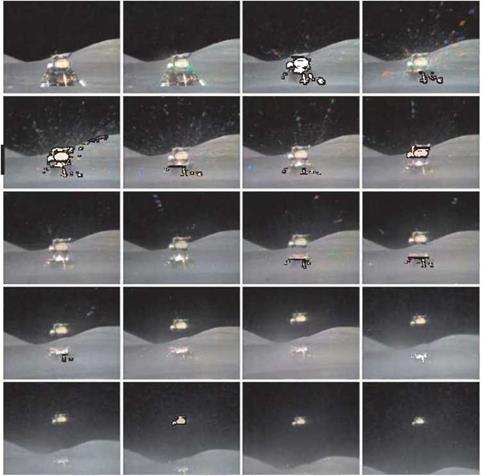
The lift-off of Challenger, Apollo 17’s LM, from coverage by the rover TV camera. (NASA) "
|
to watch the after-effects of their lift-off. “I could see radiating out, many, many particles of Kapton and pieces of thermal coating from the descent stage. It seemed almost to be going out with a slow-motion-type view. It didn’t seem to be dropping much in the near vicinity of the LM. I’m sure many of them were. They seemed to be going enormous distances from the initial pyro firing and the ascent engine impinging upon the top of the descent stage.”
“I observed one sizeable piece of the spacecraft flying along below us for a very long period of time after lift-off,” noted Armstrong. “I saw it hit the ground below us somewhere between one and two minutes into the trajectory.”
Aldrin was fascinated by the physics demonstration he was seeing: "It’s very difficult to conceive of such lightweight particles like that just taking off without any resistance at all,” he continued during his debrief. "It’s easy to think back and say
that they would do that. But it just seems so unnatural for such flimsy particles to keep moving at this constant velocity radially outward in every direction that I could see out the front window. I don’t recall seeing any impact with the ground, but there were sizeable pieces."
Just behind the two crewmen in the centre of the cabin was the cylindrical cover of the ascent engine. Many have remarked on how close two astronauts stood to an operating rocket engine. As he and Irwin flew over the meanders of Hadley Rille, Scott noted how the sound from the engine was audible through his helmet. “Both guidance systems are good, Dave." called Mitchell as the flight controllers closely watched the numbers coming up on the PGNS and the AGS.
"Okay, looks good up here." returned Scott. Then he remarked to Irwin. "It almost sounds like the wind whistling, doesn’t it?’’
Scott was impressed by the sound, and the ascent in general. “Truly amazing," he described decades later. "The LM launch and ascent were so quiet, especially when compared to Titans and Saturnsl It was almost peaceful – some vehicle oscillation, periodic at a couple of degrees, and the periodic sound of a slight wind, pulsing at about two to three seconds in frequency. And. of course, the view of the Rille as we flewr right along its course, face down. Just spectacular. Could not have been a better farewell. Most pleasant and certainly indelible.”
The gentle wobble imparted on Falcon as it soared through the lunar sky was caused by the periodic thrusting of the RCS jets. For simplicity, and to reduce the weight, the ascent engine was fixed. It could not aim its thrust anywhere but straight down along the spacecraft’s, v axis. As a result, the RCS had to do all the steering by turning the entire spacecraft and therefore aim the ascent engine in the right direction, which it did at each two-sccond cycle of the computer’s tasks. Only the downward-facing thrusters were used, there being no need to fire the upward-facing thrusters as they would be thrusting counter to the ascent engine.
The ascent was a critical event. If the APS engine were to underperform, which it never did, there was a real possibility that the LM would not achieve a stable orbit and instead would crash after less than half a revolution. The crew watched the velocity and altitude readings from both of their computers and compared them to charts, looking for any deviations that might indicate a problem. One remedy for an underperforming ascent engine was to augment its thrust with the four RCS jets that were aimed in the same direction. Because the ascent stage was relatively light and the Moon’s gravity relatively weak, the ascent engine’s rated thrust was only 15.6 kilonew tons. about the same as the first jet engines introduced during World War II. Four thrusters could provide more than one-tenth of that at 1.8 kilonewtons total a thrust that could make a difference in the later stages of a problematic ascent. With such emergency contingencies in mind, the LM’s designers had arranged the RCS plumbing so that, if their own tanks ran dry. they could draw propellant from the ascent engine’s tanks.
Once the PGNS had determined that the ascent engine had added enough velocity, it commanded a shutdown. Immediately, the crew quizzed the computer on the size of the orbit they had achieved.
“PGNS says it’s in a 40.6 by 8.9.’’ reported Scott as soon as Falcon had entered
orbit. The numbers showing on the DSKY represented the altitudes of the apolune and perilune respectively, given in nautical miles. ‘I’heir orbit appeared to be 75.2 by
16.5 kilometres, which was only slightly lower than desired.
“Roger, we copy," replied Mitchell in mission control; then reassuringly said, "the guidance still looks good to us.’’
"Okay."
Within a minute, mission control had their orbit, as determined by radio tracking, to hand. "Falcon, Houston. We have you at a 42 by 9,’’ announced Mitchell.
"You’re looking good."
"Okay. 42 by 9," confirmed Scott.
Although their tracking data put the orbit a little higher than Falcons at 77.8 by 16.7 kilometres, the trajectory experts were satisfied that the rendezvous should go ahead as planned.











